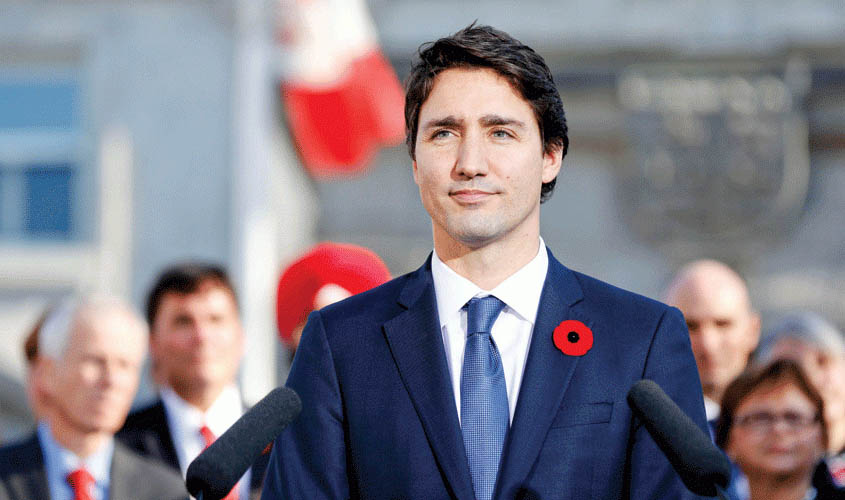New Delhi has expressed its deep concern over the presence of Canadian Prime Minister Justin Trudeau at an event to honour two legislators who in the Ontario Assembly had initiated a motion describing the 1984 anti Sikh riots as an act of genocide. What has sent alarm bells in the Indian Foreign Ministry circles is the fact that pro Khalistan slogans were raised and supporters of the two politicians waved Khalistan flags . Besides this, they also flaunted placards and posters with photographs of Jarnail Singh Bhindranwale, the former head of the Damdami Taksal who during Operation Blue Star in June, 1984 was killed along with many of his associates including General Shabeg Singh and Bhai Amrik Singh, president of All India Sikh Students Federation (AISSF). Though Trudeau may have attended the function without realising its ramifications for the Indo-Canadian relations, yet the issue has been viewed most seriously by the ministry of external affairs.
Last month the Punjab Chief Minister Amarinder Singh had declined to meet the Canadian Defence Minister Harjit Singh Sajjan during his visit to the state and had publicly charged that there existed five sympathisers of the Khalistan movement in the Trudeau Cabinet, an allegation denied by the Canadian government. In the past, Sikh militants have operated from several western countries including Canada, United States, Australia and the United Kingdom. The fear is that aided and prompted by the Pakistani intelligence agencies, certain elements may try to revive the movement for creation of a separate Sikh State. Pakistan has always wanted to foment trouble in the border areas of our country and therefore other than Kashmir, Punjab could once again be targeted.
Another development which is perturbing the South Block mandarins is that Jagmeet Singh Dhaliwal, a Sikh politician from Ontario, who was denied a Visa to travel to India after being declared a persona non grata is now seeking to run for the leadership of the New Democratic Party. On May 15th, the 38 year old is likely to make the announcement in Brampton, a Toronto suburb.
The timing of the event is not coincidental but appears to be the consequence of a well calculated move. The months of May and June have a great significance so far as the Khalistan movement goes. Operation Blue Star was viewed by the entire Sikh community as an unpardonable action by the central government which had deployed the Army to neutralise militants holed up in the Golden Temple complex in Amritsar. The charge was that the security forces had used excessive force and the attack on the Harmandir Saheb and its surrounding areas was nothing short of sacrilege of the holiest of holy Sikh shrines.
In fact, the “invasion’’ of the Golden Temple became the sole motive for the assassination of former Prime Minister Indira Gandhi who was gunned down in cold blood by her two Sikh security guards, Sub Inspector Beant Singh and Constable Satwant Singh. The anti Sikh riots, amongst the worst in Indian history, followed the gory murder of the Prime Minister. Justice continues to elude the victims’ families as no leader of any consequence has so far been found guilty of this shameful massacre of innocent Sikhs in several cities of North India, particularly Delhi.
The Canadian-Sikh Militant connection came to fore on June 23, 1985 when an Air India 747 aircraft, Kanishka which took off from Montreal for Delhi Via London exploded in mid air near the Western coast of Ireland after a bomb planted on it went off killing all the 329 passengers and crew members on board. Sikh militant outfit Babbar Khalsa was held responsible for the crash and only one miltant identified as Inderjit Singh Reyat was charged with the crime.
There was no doubt, that at that time Punjab was on the boil, and therefore subsequently the revenge-elimination of leaders and functionaries suspected to be involved in Operation Blue Star and the anti Sikh riots took place. On July, 31, 1985, Lalit Maken, Congress MP from South Delhi and his wife Geetanjali along with a party activist, Bal Kishen were gunned down followed by the shooting of Arjun Dass on September 4. The following year on August 10, General .A.S. Vaidya, former Army Chief was shot dead in Pune. The prime assassin, Harjinder Singh Jinda of Khalistan Commando Force was subsequently nabbed and executed in a Pune jail in October, 1992.
For several years, Punjab remained under a reign of terror and the state witnessed unrest and tension resulting from the actions of militants and counter actions of security forces. Several top Sikh militants hit the headlines. They included Wassan Singh Jaffarwal, Paramjit Singh Panjwar, Gurbachan Singh Manochahal, Avtar Singh Brahma, Karaj Singh Thande, Surjit Singh Penta, Nirvair Singh, Malkiat Singh Ajnala and Dr Sohan Singh. Super Cop K.P.S.Gill was amongst the most successful police officers who helped to bring the state back to normalcy.
Those were turbulent times and both the Central as well as State governments must ensure that fundamentalists operating from overseas or from our neighbouring country do not tyrannize the land which is known for its dauntless valour and spirited sacrifice. Therefore the explicitly unmistakable message that has to go out is that Punjab cannot be messed around with. Between us.

